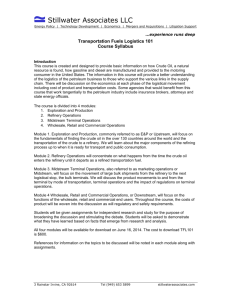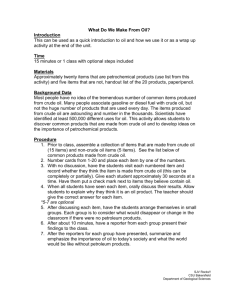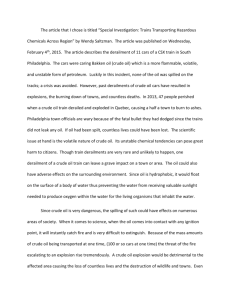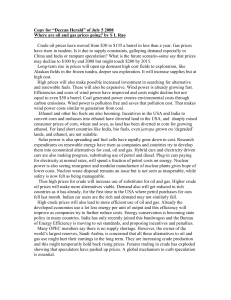Overview - United States Association for Energy Economics
advertisement
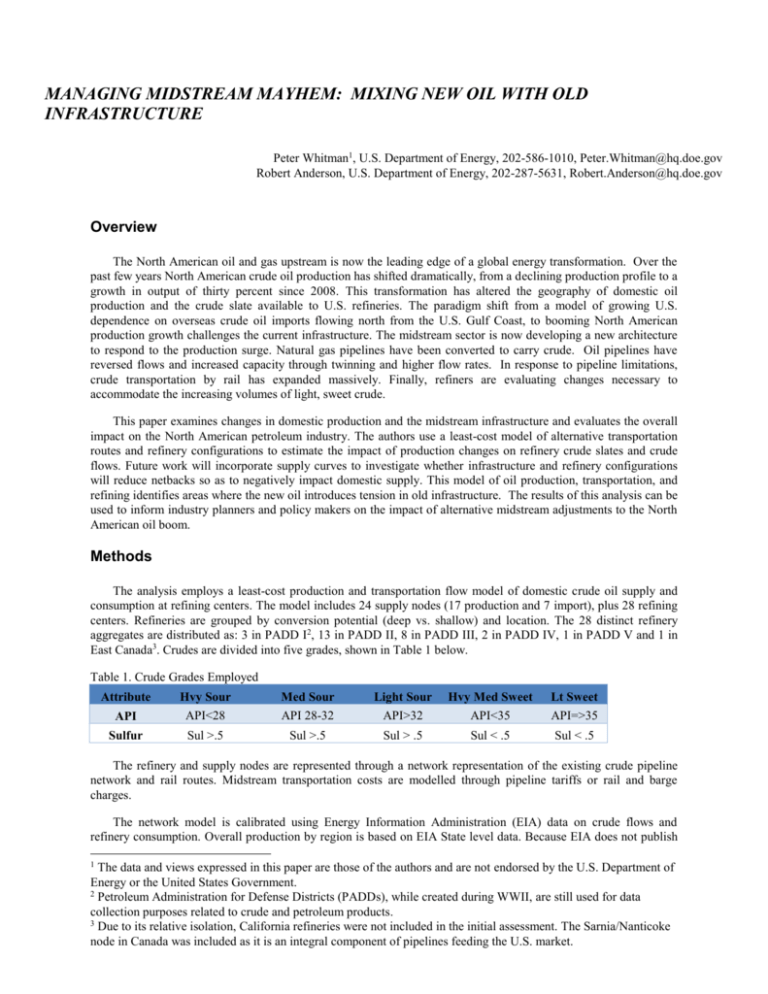
MANAGING MIDSTREAM MAYHEM: MIXING NEW OIL WITH OLD INFRASTRUCTURE Peter Whitman1, U.S. Department of Energy, 202-586-1010, Peter.Whitman@hq.doe.gov Robert Anderson, U.S. Department of Energy, 202-287-5631, Robert.Anderson@hq.doe.gov ] Overview The North American oil and gas upstream is now the leading edge of a global energy transformation. Over the past few years North American crude oil production has shifted dramatically, from a declining production profile to a growth in output of thirty percent since 2008. This transformation has altered the geography of domestic oil production and the crude slate available to U.S. refineries. The paradigm shift from a model of growing U.S. dependence on overseas crude oil imports flowing north from the U.S. Gulf Coast, to booming North American production growth challenges the current infrastructure. The midstream sector is now developing a new architecture to respond to the production surge. Natural gas pipelines have been converted to carry crude. Oil pipelines have reversed flows and increased capacity through twinning and higher flow rates. In response to pipeline limitations, crude transportation by rail has expanded massively. Finally, refiners are evaluating changes necessary to accommodate the increasing volumes of light, sweet crude. This paper examines changes in domestic production and the midstream infrastructure and evaluates the overall impact on the North American petroleum industry. The authors use a least-cost model of alternative transportation routes and refinery configurations to estimate the impact of production changes on refinery crude slates and crude flows. Future work will incorporate supply curves to investigate whether infrastructure and refinery configurations will reduce netbacks so as to negatively impact domestic supply. This model of oil production, transportation, and refining identifies areas where the new oil introduces tension in old infrastructure. The results of this analysis can be used to inform industry planners and policy makers on the impact of alternative midstream adjustments to the North American oil boom. Methods The analysis employs a least-cost production and transportation flow model of domestic crude oil supply and consumption at refining centers. The model includes 24 supply nodes (17 production and 7 import), plus 28 refining centers. Refineries are grouped by conversion potential (deep vs. shallow) and location. The 28 distinct refinery aggregates are distributed as: 3 in PADD I2, 13 in PADD II, 8 in PADD III, 2 in PADD IV, 1 in PADD V and 1 in East Canada3. Crudes are divided into five grades, shown in Table 1 below. Table 1. Crude Grades Employed Attribute Hvy Sour Med Sour Light Sour Hvy Med Sweet Lt Sweet API API<28 API 28-32 API>32 API<35 API=>35 Sulfur Sul >.5 Sul >.5 Sul > .5 Sul < .5 Sul < .5 The refinery and supply nodes are represented through a network representation of the existing crude pipeline network and rail routes. Midstream transportation costs are modelled through pipeline tariffs or rail and barge charges. The network model is calibrated using Energy Information Administration (EIA) data on crude flows and refinery consumption. Overall production by region is based on EIA State level data. Because EIA does not publish 1 The data and views expressed in this paper are those of the authors and are not endorsed by the U.S. Department of Energy or the United States Government. 2 Petroleum Administration for Defense Districts (PADDs), while created during WWII, are still used for data collection purposes related to crude and petroleum products. 3 Due to its relative isolation, California refineries were not included in the initial assessment. The Sarnia/Nanticoke node in Canada was included as it is an integral component of pipelines feeding the U.S. market. production by crude quality, disaggregated production by grade was estimated from the EIA data informed by selected stream qualities. Refinery processing capability was characterized by limiting the crude slate bottoms percent. The fraction of bottoms represents roughly the proportion of crude that requires additional processing after going through the Atmospheric Crude Unit (ACU). Heavier crudes tend to have a larger fraction of bottoms, or streams that will require additional processing. Constraints were placed on the capability of the refinery to diverge from historical crude slate, representing limitations on the flexibility of the refinery to adapt to the changing crudes available. Overall refinery processing capability was estimated from historical consumption. The model optimizes the network among producers, transporters, and refiners by minimizing costs. All crude prices were specified as differences to a marker crude. Crude streams were assigned locational price deltas and quality deltas. Transportation costs were primarily based on current tariffs when available. Refineries were then assigned differential operating costs for operating with light or heavy crude. Results We show the distribution of crudes consumed for 3 years: 2012, 2015, and 2020 for two key PADDS: the Midwest (PADD II) and the Gulf Coast (PADD III) in Figures 1 and 2. In PADD II, increasing heavy oil (primarily oil sands) along with additional deep refining capacity increases the fraction of heavy crude processed at the expense of middle grades. In PADD III, mid-grade crude processing also declines but is replaced by light crudes from the Permian and Eagle Ford basins rather than additional heavy crudes. Figure 1. Crude Quality Fraction by Year PADD II Figure 2. Crude Quality Fraction by Year PADD III As domestic crude production increases, waterborne imports become less economic and dwindle. In Figure 3, the primary result of increased domestic production is a decline in waterborne imports to the Gulf Coast, with a smaller decrease to the East Coast as rail takes a larger share of crude consumption there. Heavy sour imports from Canada continue to increase, while all other grades drop sharply. Figure 3. Imports by Region Figure 4. Imports by Crude Grade Conclusions Increasing US production of light crudes and Canadian production of heavy crudes will have only a relatively modest impact on overall U.S. refining. Currently planned pipeline infrastructure, such as the increased pipeline capacity from the Permian basin to the refining centers on the Gulf Coast, along with other pipelines and rail will likely accommodate changing crude flows. Relatively modest changes in refinery configuration may be sufficient to accommodate the changing crude slate, though profitability may potentially be impacted.

